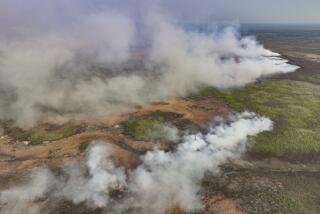Terrain hinders fire crews in Virginia’s Great Dismal Swamp
The Great Dismal Swamp, befitting its name, is not the most hospitable of places.
The 110,000 acres of unforgiving forested marshland in southeastern Virginia served as refuge for fleeing Native Americans in the 1600s and runaway slaves in the 1800s.
The same inaccessibility that provided protection to some in the past has created difficulties for crews battling a wildfire that has charred more than 6,000 acres at the national wildlife refuge since Aug. 4.
“There are vines so thick that you get tangled up if you don’t have a machete,” said deputy refuge manager Cindy Lane. “They have thorns that will rip your clothes to shreds.”
The 433 firefighters battling the blaze must deal not only with rough terrain, but also the particular nature of a swamp fire.
Typically, wildfires burn outward and above ground, extending their perimeter, said Tracy Farley, a spokeswoman for the multi-agency effort fighting this blaze, the Lateral West fire.
But flames have ignited patches of the abundant marsh peat — soil made up of partially decayed organic material, such as trees and grasses. The peat smolders and burns underground, leaving no visible flames to fight.
“Although the fire keeps going outward, it also is burning downward,” Farley said.
Fire crews have begun pumping water from nearby Lake Drummond to flood the smoldering areas. Helicopters drop large pumps into the dense, inaccessible areas of the swamp that crews have been unable to reach with bulldozers and tractors. Firefighters lug pipes and hoses to the pumps, which are then connected to the water source to inundate the fiery peat, Farley said.
“Access and terrain has been a big issue here,” she said. “It’s very difficult getting to the places you need to go.”
The carbon-rich peat has sent billowing plumes of smoke across Virginia, blanketing the nearby city of Suffolk and reaching as far as Annapolis, Md., about 420 miles away, said Bill Hayden, spokesman for the Virginia Department of Environmental Quality.
The fire, which was 15% contained Friday, has not threatened any structures or people, but has ravaged delicate areas in the refuge.
“There have been fires in the Dismal Swamp forever; it’s a normal thing,” Lane said. “But this is the worst one we’ve had since it became a wildlife refuge in 1974.”
Though no dead animals have been found, the fast-moving blaze almost certainly has killed some slower-moving creatures, such as turtles, snakes and frogs, Lane said. The fire has also destroyed much of the work done to restore the Atlantic white cedar, which has been dwindling in the area.
Before European settlers descended on the area in the 1600s, Native American tribes lived on the edge of the swamp and used it for hunting. But by the 1650s, tensions had risen between the groups and some Native Americans moved into the swamp.
Two centuries later, runaway slaves developed maroon colonies in the swamp and lived off the land, Lane said.
Widespread logging, canals and the growth of nearby towns shrank the swamp considerably beginning in the 19th century. At its peak, the swamp was about double its current size.
More to Read
Start your day right
Sign up for Essential California for news, features and recommendations from the L.A. Times and beyond in your inbox six days a week.
You may occasionally receive promotional content from the Los Angeles Times.







